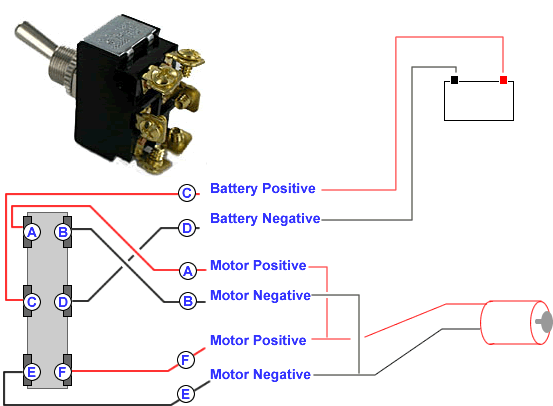A 3 Position 6 terminal toggle switch can be used in many other applications and in many other wiring variations. Here we’ll cover how to use a 3 position 6 blade toggle to run a 12Volt DC motor or 12Volt actuator in forward and reverse directions. This isn’t a very complicated procedure and we’re confident that most folks should be able to accomplish this task.
Let’s say we have a 12Volt DC motor that we’d like to have spin in one direction sometimes and other times spin in the opposite direction. If we connect the motor’s positive power wire to a 12Volt battery’s positive terminal, and the motor’s negative power wire to the 12Volt battery’s negative terminal the motor would spin forward.
On the other hand:
If we connect the motor’s positive power wire to the 12Volt battery’s negative terminal and the motor’s negative power wire to the 12Volt battery’s positive terminal (otherwise known as “Reverse Polarity”) the motor will spin backward.
This can also be done for a 12Volt DC actuator. For example, a door lock actuator will thrust outward with a straight connection to a 12Volt battery. When the polarity is reversed (actuator is hooked up “backwards” to the 12Volt battery) the actuator will be retracted inward. Connection and thrust directions may vary from model to model but the idea is the same for all two position 12Volt DC actuators.
So let’s hook-up that 6 terminal toggle switch!
The very first step is ALWAYS to make sure that your toggle switch is rated to handle the amount of power your DC motor or DC actuator will draw. If your motor is rated at 15 amps you will need a toggle that rated at or above 15 amps. It is normally a good idea to use a switch with a rating higher than what your motor needs. There’s just no sense in pushing the toggle to it’s limits and risking damage.
The second and likely the most obvious is to find the perfect location. We’ll leave this up to you. Just make sure to leave room for the wires and wire terminals you will use.
The third step should be to run the wiring to your 12Volt motor or 12Volt actuator. Connecting the toggle switch to your 12Volt battery should be the VERY LAST step.
Here is an example of how to hook-up either a 12Volt Motor or a 12Volt DC actuator. They are both done the same way.

What it all boils down to is this, you will have two wires to hook-up to your 12Volt battery and two wires to hook-up to your motor or actuator. Actually using red and black wire helps to keep your head straight too.
Terminal wire A connects to terminal wire F and then to the positive lead of your 12Volt DC motor or DC actuator. Terminal wire B connects to terminal wire E and then to the negative lead of your 12Volt DC motor or DC actuator.
Now when the toggle is in the “Center” or “OFF” position it is not contacting either A-B or E-F. When the toggle is flipped forward the C terminal will internally make a connection to the A terminal, at the same time; the D terminal will internally make a connection to the B terminal. When the toggle is flipped back past “OFF” to the backward position the internal connections become C to E and D to F. For a better understanding of how toggle and rocker switches work; look for our Knowledge Base article on “How Toggle and Rocker Switches Work”.
When the switch is in the forward position the power is sent from the 12Volt battery to the DC motor or DC actuator in a “straight” fashion. e.g. Positive to Positive and Negative to Negative. When the switch is in the backward position the power is sent from the 12Volt battery to the DC motor or DC actuator in a “flipped” fashion. e.g. The battery’s Positive gets connected to the motor’s Negative and the battery’s Negative gets connected to the motor’s Positive. Sounds a bit backwards but that’s the idea, isn’t it?
It shouldn’t matter which end of the switch body you consider “A-B” so long as the opposite end is treated as “E-F”.
This can also be done with a 2 position switch but it will always be in an “ON” position. This would likely not be good for dc actuators or any other dc powered item that you wouldn’t want to run continuously.
In addition: If your application only requires power to be delivered for a short period of time you will most likely want to use a “Momentary” type switch. If your application requires that power be delivered continuously over a long period of time you will likely want to use a “Constant” type switch.
6-Blade 3-Position Toggle Switch | Toggle Switches | Wire Terminals

